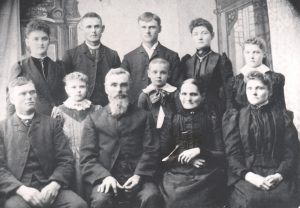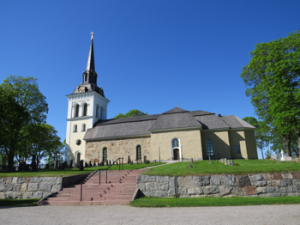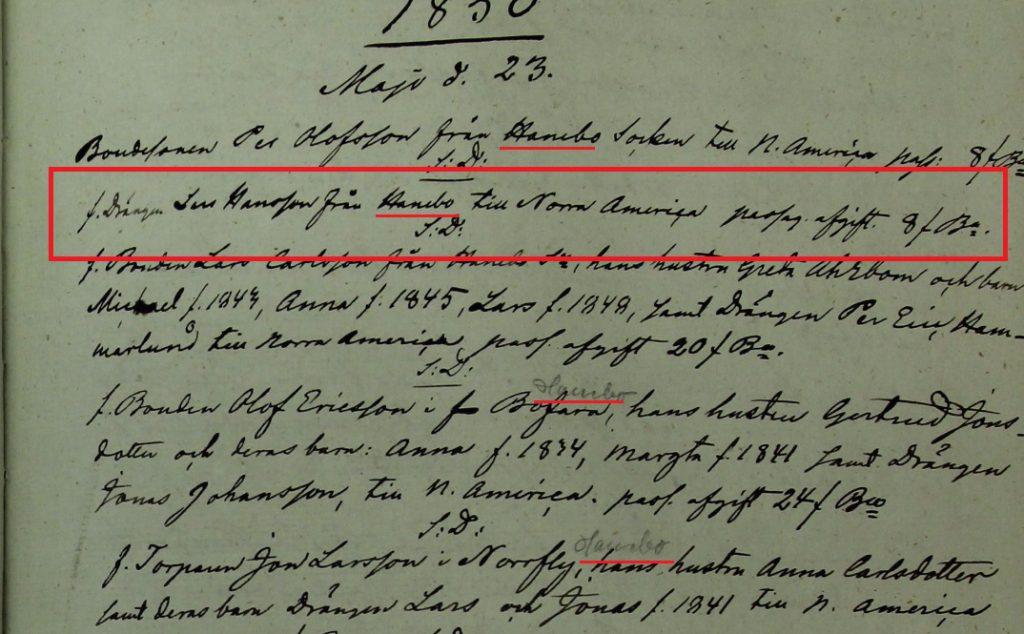Taking a look at immigration timelines for my Swedish ancestors, I see that my Hultman and Hanson families (on the Rudeen side) were the first to come to America. Swedish immigration records are kind of sketchy up until 1869, and these folks came to America much earlier – between 1850 and 1854. That means there are a lot of unanswered questions and gaps that are hard to fill. I’ve made some progress since I last wrote about them.

Louis (Lars) Hanson was my first Swedish ancestor to come to America. He came in 1850 at the age of 19, and I’m now convinced that he was in some way connected with the Janssonist colonists who settled in Bishop Hill in Henry County, Illinois. (I’ll be calling him ‘Lars’ when I talk about his life in Sweden; I will call him ‘Louis’ when I talk about his life in America.)
His wife, Lisa Stena Hultman, came with her parents in 1854 at the age of 11. I’m not yet sure why the Hultmans left Sweden, nor why they chose to settle in Henry County. I don’t know if they were part of the Janssonist movement.
This will probably be the first of a series of posts about these two families, their emigration from Sweden, and their migration within the United States from the early 1850’s until after the Civil War.
In this first post, let’s take a look at the Janssonist movement.
Erik Jansson was the leader of a breakaway religious movement that came to America in 1846. I highly recommend this video for a great overview of the colony. If you are a descendant of Louis Hanson, this is required watching! It’s about 17 minutes long.
Another good source of information is the Bishop Hill Heritage Association website, where they have a brief history and a page of links to some excellent source material.
The video makes mention of the Amana Colonies in Iowa as a similar type of movement – coincidentally, Dale and I just visited there last month. The Bishop Hill Colony lasted about 14 years before it was dissolved; the Amana Colonies lasted 80 years. The Mormons are also mentioned as a similar type of group, and of course their movement was successful and continues to this day.
When we first find Louis in the United States Census records in 1860, he is married to Lisa Stena and living in Knox County, Illinois. So why do I think that Louis Hanson was part of the Bishop Hill colony?
Let’s take a look at his life back in Sweden. He was from the parish of Hanebo, located about 160 miles north of Stockholm.

The fact that he was from Hanebo is important. Erik Jansson visited Hanebo in 1843 and convened many meetings there and recruited followers.
A prominent Bishop Hill colonist family, the Hedlunds, also came from Hanebo. In fact, the Hedlund family left for America the very same day that Lars did! In the following “Moving Out” register from 1850, we see see entry number 5 for the Hedlund family (Karl and Anna and their sons Carl and Per and daughter Anna), then farther on down entry number 12 for Lars Hansson. They left on “13/5” (that means May 13) and their destination was “Amerika”.
The fate of the Hedlund family is well known and well documented1. They were part of the 7th wave of original colonists who came to Bishop Hill. Just as this group left Sweden, the colony’s controversial founder Erik Jansson was murdered in the courthouse in Cambridge, Illinois. They probably didn’t learn of this until they arrived! But that wasn’t the worst of their troubles:
A seventh party came over in 1850, under the joint leadership of Olof Johnson and Olof Stoneberg, who had returned to Sweden in order to collect moneys due and inheritances of minors, as also to gather up the remainder of the sect. The sum they brought back is said to have amounted to $6,000. The emigrant party was composed of 160 persons, who under Stoneberg’s supervision embarked at Söderhamn. On the ocean ten persons died. At Buffalo the whole company was taken on board an old propeller steamer bound for Milwaukee. Owing to bad weather and breakage in the machinery, the trip took two weeks and their provisions gave out. In Michigan, where the steamer touched, cholera added to their miseries, carrying off fifty or sixty of the party before Milwaukee was reached. A Swedish-American of that city, C. Blanxius by name, learning by chance that a party of his countrymen had arrived, at once provided care and medical service fo rthe sick. Upon learning afterwards that Stoneberg had several thousand dollars in his possession, he compelled him to pay the bills.2
Was Lars part of the seventh party of Bishop Hill Colonists? Besides coming from the same parish as other known colonists, I’ve also confirmed that he was issued a traveling passport back in Sweden on the same day as the others. The entry for Lars is in the red box. The passports were issued on May 23, ten days after they all left Hanebo.
In Söderhamn, the group boarded the ship Aeolus, which landed in New York Harbor on September 17. I can find most of the Hanebo emigrants on the passenger manifest, but Lars is not among them. There is, however, an Eric Hanser (or something like that, it’s hard to read), age 19, traveling without any family members. Ship’s manifests are among the messiest records around – so this could be what the English-speaking ship’s steward wrote down for Lars Hanson. Maybe? I actually believe it’s likely.
(Something else I noticed in the manifest was that the leader of the group Olof Stoneberg – the guy with all the money – stayed in the cabin while all the other emigrants were in steerage.)
If indeed Lars was part of this group, he was lucky to have survived!
In all the lists of Bishop Hill colonists that I could find, a Lars or Louis Hanson is not included. His obituary states that he went off to the California gold fields from 1852 to 1856. So his time in Bishop Hill would have been brief. Perhaps he was disillusioned by what he found on arrival. Several of the Hanebo parishioners didn’t survive the trip, so perhaps he had little in the way of personal attachments to those who did.
1see these blog entries about Peter Hedlund and the unusual musical instrument that he made. Peter (Per in Sweden) was just two years younger than Lars; Lars probably knew him well.
2from “History of the Swedes of Illinois” by Olson et al, 1908, pp. 227-228


